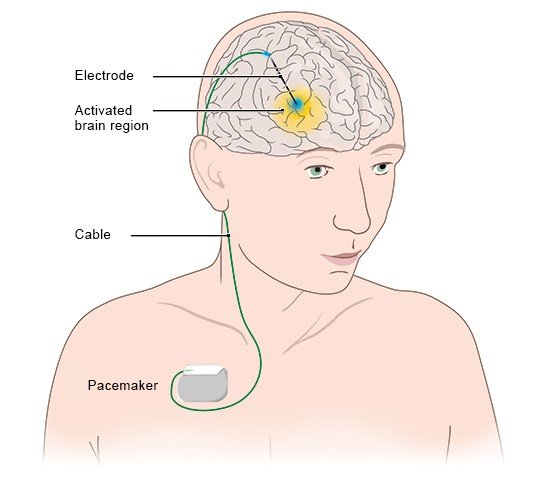Arbeitsgemeinschaft Tiefe Hirnstimulation. Informationen zur Tiefen Hirnstimulation für Patienten. 2019.
Deuschl G, Schade-Brittinger C, Krack P et al. A randomized trial of deep-brain stimulation for Parkinson's disease. N Engl J Med 2006; 355(9): 896-908.
Deutsche Forschungsgemeinschaft (DFG). Tiefe Hirnstimulation. Stand der Wissenschaft und Perspektiven. 2017.
Deutsche Gesellschaft für Neurologie (DGN). Idiopathisches Parkinson-Syndrom (S3-Leitlinie, in Überarbeitung). AWMF-Registernr.: 030-010. 2016.
Hamberg K, Hariz GM. The decision-making process leading to deep brain stimulation in men and women with parkinson's disease – an interview study. BMC Neurol 2014; 14: 89.
Hariz GM, Hamberg K. Perceptions of living with a device-based treatment: an account of patients treated with deep brain stimulation for Parkinson's disease. Neuromodulation 2014; 17(3): 272-277; discussion 277-278.
Hariz GM, Limousin P, Hamberg K. "DBS means everything – for some time". Patients' Perspectives on Daily Life with Deep Brain Stimulation for Parkinson's Disease. J Parkinsons Dis 2016; 6(2): 335-347.
Schuepbach WM, Rau J, Knudsen K et al. Neurostimulation for Parkinson's disease with early motor complications. N Engl J Med 2013; 368(7): 610-622.
Weaver FM, Follett K, Stern M et al. Bilateral deep brain stimulation vs best medical therapy for patients with advanced Parkinson disease: a randomized controlled trial. JAMA 2009; 301(1): 63-73.
Williams A, Gill S, Varma T et al. Deep brain stimulation plus best medical therapy versus best medical therapy alone for advanced Parkinson's disease (PD SURG trial): a randomised, open-label trial. Lancet Neurol 2010; 9(6): 581-591.
Xie CL, Shao B, Chen J et al. Effects of neurostimulation for advanced Parkinson's disease patients on motor symptoms: A multiple-treatments meta-analysis of randomized controlled trials. Sci Rep 2016; 6: 25285.
IQWiG health information is written with the aim of helping people understand the advantages and disadvantages of the main treatment options and health care services.
Because IQWiG is a German institute, some of the information provided here is specific to the German health care system. The suitability of any of the described options in an individual case can be determined by talking to a doctor. informedhealth.org can provide support for talks with doctors and other medical professionals, but cannot replace them. We do not offer individual consultations.
Our information is based on the results of good-quality studies. It is written by a team of health care professionals, scientists and editors, and reviewed by external experts. You can find a detailed description of how our health information is produced and updated in our methods.


